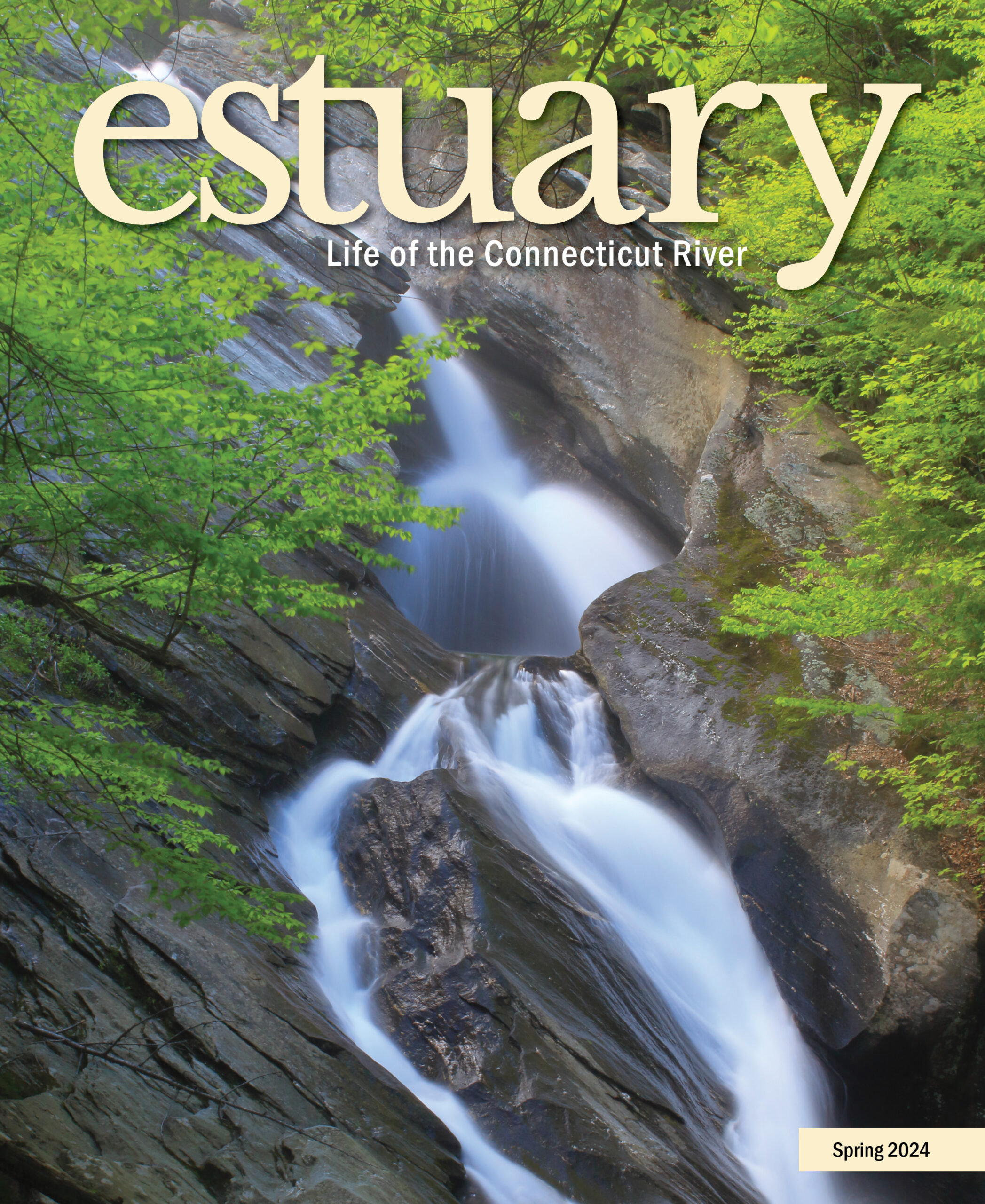 This article appears in the Spring 2024 issue
This article appears in the Spring 2024 issue
Celebrating Microcultures
Sustainability and Beauty at Centerbrook Architects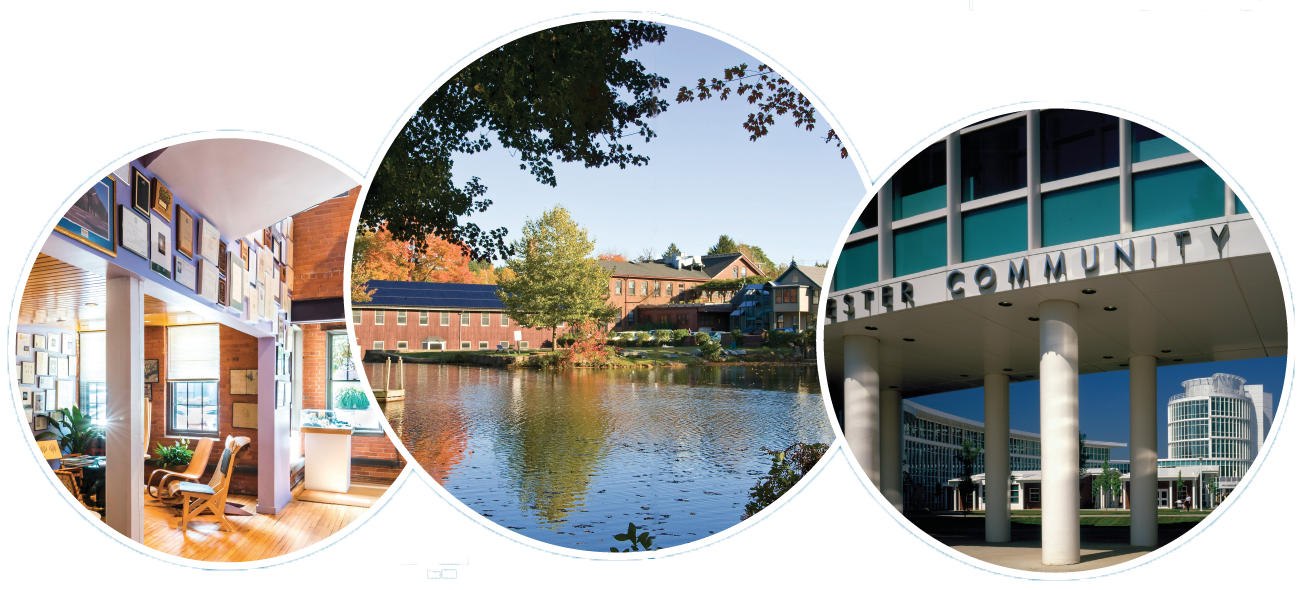
By Eric D. Lehman
Left: The foyer of Centerbrook Architects blends effortlessly with the brick factory shell, receiving visitors into a unique and magical space. Middle: The Centerbrook factory complex shines in autumn light reflected from the Mill Pond. Right: Projects in the Connecticut River valley, like Manchester Community College, have helped Centerbrook shape the academic architecture of New England. Image Credits: Getty Images/Apostrophes (blue background), Jeff Goldberg/ESTO (Manchester Community College), and Derek Hayn/Centerbrook ( Centerbrook factory and foyer).
On a tributary a mile west of the Connecticut River, above an old milldam in Centerbrook, Connecticut, a small former auger bit factory breathes the 21st century air. At first, indistinguishable from hundreds of other factories across the New England landscape, you quickly notice something different: this one pulses with energy and life. The Falls River rushes over the old weir, herring and alewives climb a fish ladder, and a small turbine generates waterpower above the tail race. New structures seamlessly blend with the old brick textures. The rooftop garden and solar panels might feel out of place in some 19th century spaces, but not this one. It has been brought into the future, into the now.
Entering the former factory through a modest brick portico, you walk past a dozen individually handmade chairs, bathed in a soft, perfect light that animates dozens of architects, designers, planners, and craftspeople, all charged with creative purpose. This beautifully redesigned and reconnected labyrinth winds on and on through an array of rooms, offices, and transitional spaces. You step across rough floors, between blocks of buttery blond wood, and into one of those rare interactions of place and people that give life to the world.
This is Centerbrook Architects, and they have worked on the banks of this river for almost fifty years, solving problems of landscape and necessity, balancing human interaction and aesthetics. They make gorgeous livable private homes like the Lakewood House with a closed-loop geothermal system. But what they are best known for is their comfortable public buildings—institutional spaces that feel both luxurious and clean, full of generous spaces for thought and work. Along with designing buildings in places like California, Florida, North Carolina, Colorado, Ohio, Texas, and Pennsylvania, they have greatly influenced the look and feel of many academic institutions in New England. “People say to us, you get all the good jobs,” says Mark Simon, one of the five principal architects. “And we say, no, no, no, we make all the good jobs.”
In Connecticut projects include many buildings at Yale University, several at the Hotchkiss School, and dozens at Quinnipiac University. The firm has designed public icons like the Thompson Exhibition Building at Mystic Seaport Museum and The Ocean House in Watch Hill, Rhode Island. They have designed buildings throughout the Connecticut River watershed, including the Floren Varsity House at Dartmouth College, and the “medieval city” of Manchester Community College and the Outpatient Pavilion at UConn Health in Connecticut. The adaptive renovation at the Hill-Stead Museum was recognized in 2021 by the Connecticut Chapter of the American Institute of Architects with its Elizabeth Mills Brown Excellence Award.
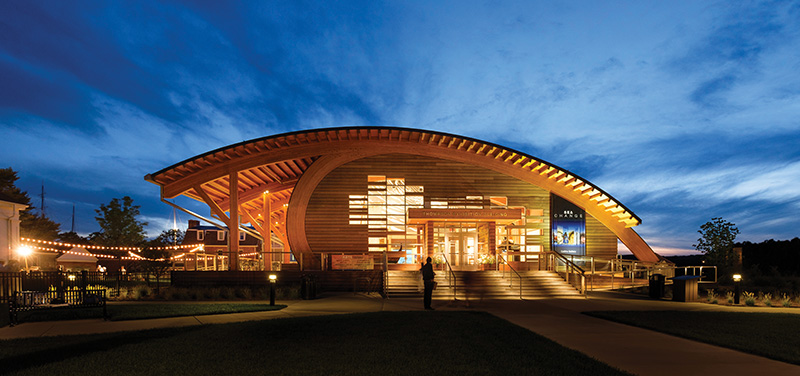
The instantly iconic Thompson Exhibition Building at Mystic Seaport draws its inspiration from the shape of a crashing wave. Image Credit: Derek Hayn/Centerbrook
And yet, each building remains distinct, perfectly placed in the context that surrounds it. The Florence Griswold Museum’s Krieble Gallery in Old Lyme alludes to the curves of art nouveau, while the Jackson Laboratory for Genomic Medicine in Farmington references shingle-style houses in its zinc cladding. “Our sense of place is the result of different streams—the culture and the history of the place, the particular culture,” Simon emphasizes. “Does the building speak to that culture, and also does it express it? We like to say we’re interested in the particular rather than the general. That’s why each of our buildings is different.”
We might productively call these particular places that Simon is talking about, “microcultures,” a term that localizes the idea of culture into a small, specific community that makes up or is served by an institution, university, or company. These microcultures have unique identities that develop from or around their landscapes and locations. They grow and change over time and both influence and are influenced by the people and the architecture they interact with. And of course, the term also applies to the community at Centerbrook Architects itself.
This firm was founded in 1975 by postmodern architect Charles W. Moore, who lived in the house next door, now connected by a breezeway. Moore was the Dean of the Yale School of Architecture, and his residential design book, The Place of Houses, influenced many artists to focus their efforts on the “spirit of place.” Mark Simon was his student at Yale, and today he is joined by Jim Childress, Todd Andrews, Elizabeth Hedde, and Justin Hedde, along with fifty-six other talented people from nine countries and a dozen states. Together, they have won over 420 design awards, including the coveted American Institute of Architects Firm Award in 1998.
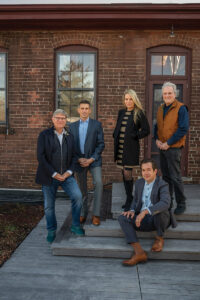
The principals of Centerbrook from left to right: Jim Childress,
Todd Andrews, Elizabeth Hedde, Justin Hedde, and Mark Simon. Image Credit: Maggie Conley.
“I like the metaphor of making music,” says Jim Childress. “It’s a little like jazz; it kind of starts with an idea, and everybody adds a piece to it.”
It takes this creative village of jazz musicians and their many allies to finish each of these endeavors. One of the buildings they collectively worked on is the renovation and expansion of the Yale Peabody Museum slated to open early in 2024. “Mark was the principal in charge of redesigning the Peabody; I worked under him with at least 100 team members, just for the digital model,” says Justin Hedde. “And then hundreds more for the actual building.” It also takes a long time; in the case of the Peabody, eighteen years from the first discussion until now. Andrew Santaniello has been working on it for six years. “It’s a once-in-a-career kind of project,” he says. “We were afforded an amazing opportunity, and now we can see it really come to life.”
The firm’s home in Centerbrook is a key part of its identity. One of the founders, Bill Grover, discovered this neglected auger factory for sale when taking the back roads from a job in Norwich. He convinced his partners to move from New Haven, and his vision shaped the property, allowing it to develop and grow. The firm “started as Moore Grover Harper, but once they came here, they recognized that the place embodies who we are and what we stand for,” says Todd Andrews, who Grover hired almost three decades ago and is now a principal. “There are star architects, but we are about sharing passion, as Centerbrook, not as individuals.”
That shared passion includes a love of the Falls River, which flows past the Ivoryton Playhouse, over the mill dam, and down to North Cove in Essex. “We’re literally part of the lower Connecticut River estuary,” says Chris Hill, the firm’s marketing and business development director. He grew up here and clearly remembers the terrible 1982 flood that damaged the town. “This is our home,” continues Hill. “It reflects our history and philosophy of design. It endures.”
The river plays a daily role in the life of the firm. Andrews keeps a canoe ready to go in the summer, and in the winter he and others skate and play ice hockey on the frozen pond. “We’ve all come to this place intentionally,” he says. “I think our firm’s size really let’s us get to know each other, and that has an impact on the work we do.”
But the river is not just for battling over a hockey puck; it plays a central part of the firm’s mission of stewardship and sustainability. A steeppass fishway, beautifully designed by the firm with Chester-based Nathan L. Jacobson and Associates, climbs from the output of the tail race up the rocky edge of the mill pond. Conceived by The Nature Conservancy and funded by the John T. and Jane A. Wiederhold Foundation, it helps alewives and other anadromous fish make their way through several turn pools, one of which includes a viewing window. The fish who make it to the Mill Pond find a calm, freshwater spawning ground.
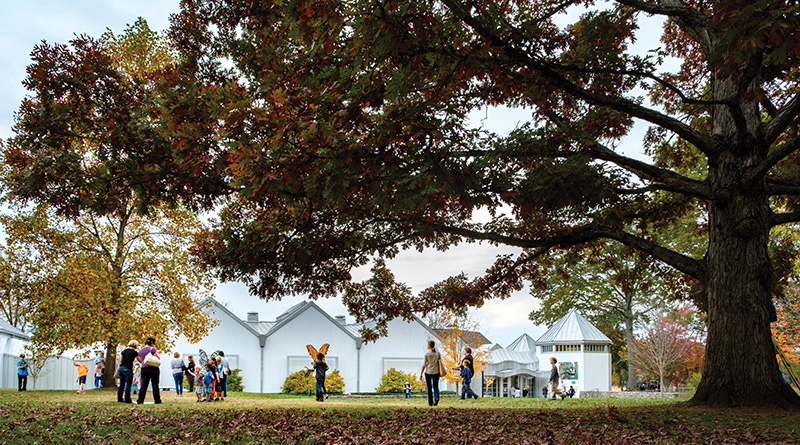
The Robert and Nancy Krieble Gallery at the Florence Griswold Museum is one of Centerbrook’s many impeccably designed structures in the Connecticut River valley. Image Credit: Derek Hayn/Centerbrook
“What struck me was how the alewives travel down to Georgia in the Atlantic Ocean, and they are coming right back up to our little mill pond,” says Justin Hedde. “And because we have this little intervention, we’re able to impact something that’s way out in the Atlantic.”
Meanwhile, the mill race flows under the factory itself, where a low-head hydroturbine attached to a concrete water tank rotates and turns a DC power generator. The firm makes about 10% of its power with this small device. “We use the waterfall to make power and have a submerged cooling loop in the pond,” says Simon. “We’re engaged with it in both emotional and functional ways.”
The fish ladder and power generator are not the only ways the architects have integrated into their environment. The old factory was built before modern insulation and air barriers, so in a way it helps them test energy efficiency right at home. The former acid pickling room of the auger factory has been designated the “ecolab,” where they use sensors to track humidity, temperature, CO2 levels, particulate matter, energy loss, and airflow and to test interventions to see their effects. “How can we manage this building? How will that help us manage other buildings?” Hill asks rhetorically. “We think of this entire place as a laboratory—nothing is too precious.”
This deep connection to sustainability and place influences the design philosophy that has made Centerbrook Architects so popular and respected. They learn everything they can about each client that they work with and explore the design together. Together they are able to create a strong architectural identity but make it unique to that one place rather than repeating it elsewhere. “We take a sustainability approach in spite of people not having the money to do it, and sometimes in climates that are miserable and cold,” says Childress. “You have to go and experience that place and think about the challenge. Gee, do we have to do it that way? Can we impact it another way by design?”
“Endearing is enduring,” agrees Elizabeth Hedde. “Buildings that people love stick around. And that’s one of the most sustainable things you can do: design a building that lasts.”
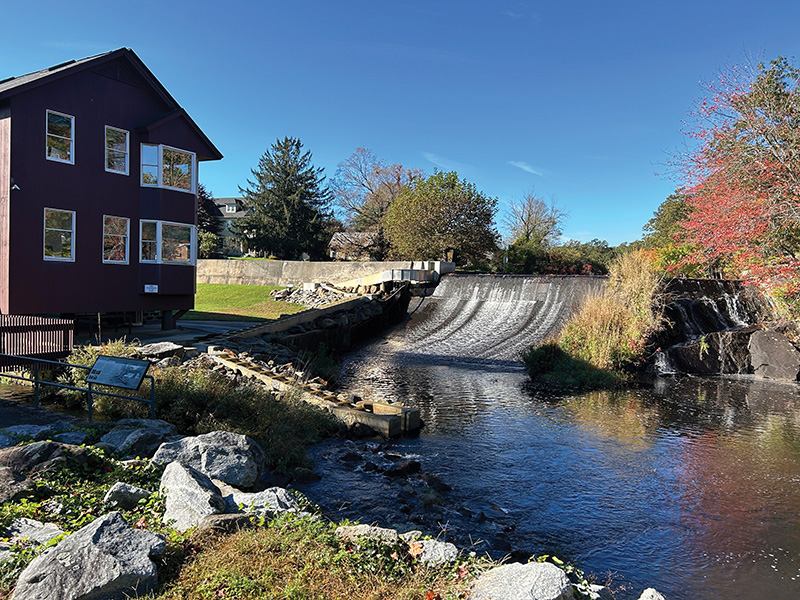
The John T. and Jane A. Wiederhold Fishway climbs from the output of the hydroturbine tail race up the rocky edge of the spillway, helping anadromous fish like alewives reach their spawning grounds. Image Credit: Chris Hill/Centerbrook.
There is no chasing some theoretical grail here at Centerbrook; this is architecture as the art of the practical. “It’s human-based, what’s delightful and functional and comfortable for humans to be in,” continues Hedde. “And flexibility is really important, because frequently our clients can’t afford some novel feature. So we have to test ideas and see if they’re going to be usable and have a big impact for what they cost.”
It’s a big task that requires recruiting the best creative minds. And while it can be a challenge to lure architects away from the big cities, the firm has remarkably low turnover. When people come here to this microculture in the lower Connecticut River valley, they stay. Jiaying Bai grew up in Nanjing, China, attended the Rhode Island School of Design, and now works on cutting-edge 3D modeling and designing. “This is a magical place,” she says. “It makes me smile every day.”
When asked why Centerbrook is so magical, the principal architects can’t seem to put it exactly into words. Justin Hedde declares that it allows space to create. Jim Childress cites the way talented people from all over the world have gathered together. Todd Andrews cites the old factory’s messy vitality, while Elizabeth Hedde muses on the quieter pace of life. Perhaps the answer is all of these things, or perhaps they all add up to something more.
On a Friday after lunch all the employees gather on the rough wooden floor of the “Cube,” a large room in the center of the complex. In the corner of the room a round window cut in the floor looks directly down at the hydroturbine and the motion of the mill race. As everyone lounges on handmade chairs and sips coffee, Senior Director Charles Mueller speaks about his recent visit to Longwood Gardens in Pennsylvania, flipping through photos on a large screen. The entire firm enjoys this midday break to learn, to relax, and to inspire the next series of projects: chapels and synagogues, museums and music halls, classrooms and family rooms. Who knows?
But one thing is sure—the results will be human buildings that celebrate each microculture, each client, each terrain. Soon, the talk is over, everyone claps and walks back to their desks, and the river of ideas flows on.
Eric Lehman is the award-winning author of 22 books, including New England Nature, New England at 400, Quotable New Englander, and A History of Connecticut Food.
